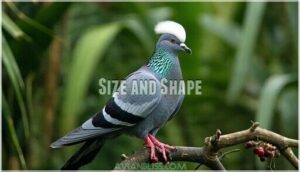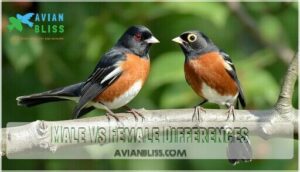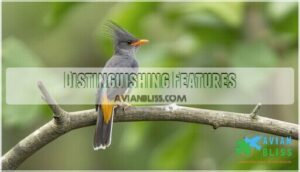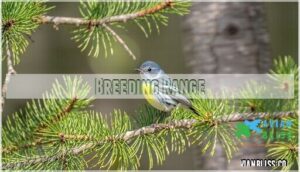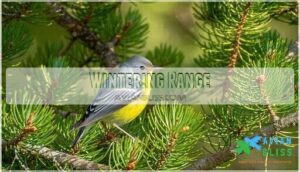This site is supported by our readers. We may earn a commission, at no cost to you, if you purchase through links.
 You’ll spot the rose breasted grosbeak by its chunky build and that signature oversized triangular bill that cracks seeds like nobody’s business.
You’ll spot the rose breasted grosbeak by its chunky build and that signature oversized triangular bill that cracks seeds like nobody’s business.
Males flash a brilliant red triangle on their white chest, while females sport warm brown streaking.
These medium-sized songbirds measure 7-8 inches and breed in eastern North America’s deciduous forests before heading south for winter.
They’re methodical foragers with melodious songs and sharp "chink" calls.
Both parents share nest duties equally, feeding protein-rich insects to their young.
Their seasonal diet shifts from insects to seeds and berries, making black oil sunflower seeds your best bet for attracting them to feeders, with a focus on their deciduous forests habitat.
Table Of Contents
- Key Takeaways
- Physical Characteristics and Identification
- Habitat and Geographic Range
- Behavior and Vocalizations
- Diet and Feeding Habits
- Nesting and Conservation
- Frequently Asked Questions (FAQs)
- Where do rose-breasted grosbeaks breed?
- Are rose-breasted grosbeaks aggressive?
- Are rose-breasted grosbeaks endangered?
- How rare is it to see a Rose-breasted Grosbeak?
- What does a female Rose-breasted Grosbeak look like?
- Are Rose-breasted Grosbeak both male and female?
- What attracts Rose-breasted Grosbeak?
- How often do they migrate?
- What do their nests look like?
- How does their song differ from their calls?
- Conclusion
Key Takeaways
- You’ll easily identify them by their chunky build and oversized triangular bill – males sport a brilliant red chest triangle on white plumage, while females have warm brown streaking that resembles that of large sparrows.
- They’re seasonal visitors you can attract with the right setup – offer black oil sunflower seeds at feeders near deciduous trees during spring migration (early May) when they’re traveling between breeding grounds and Central American wintering areas.
- Both parents share parenting duties equally, making them unique among songbirds – they’ll methodically forage for protein-rich insects to feed their young while also defending their territory with melodious songs and sharp "chink" calls.
- Their diet shifts dramatically with the seasons – they focus on insects during breeding season for protein, then switch to seeds and berries during migration and winter, making them adaptable backyard visitors when food sources align.
Physical Characteristics and Identification
You’ll easily recognize Rose-breasted Grosbeaks by their stocky build and distinctive triangular bills. These medium-sized songbirds measure 7-8 inches long with striking differences between males and females.
With their stocky build and triangular bills, these striking songbirds are impossible to miss in your backyard
Size and Shape
You’ll recognize Rose-breasted Grosbeaks by their distinctive stocky build and sturdy appearance.
These medium-sized songbirds fall between American Robins and House Finches on the bird size comparison scale.
Key size measurements include:
- Body Length: 7.1-8.3 inches (18-21 cm)
- Wing Span: 11.4-13.0 inches (29-33 cm)
- Weight: 1.4-1.7 ounces (39-49 grams)
- Tail Shape: Medium-length and squared
Their broad chest, short neck, and triangular beak size create their characteristic chunky silhouette.
Coloration and Markings
You’ll spot striking plumage patterns that make rose breasted grosbeaks unmistakable in your backyard.
Their vibrant coloration creates stunning color schemes that change with gender and season.
| Feature | Male | Female |
|---|---|---|
| Head Color | Jet black | Brown with streaks |
| Chest Marking | Rose-red triangle | Streaked brown-white |
| Wing Pattern | White patches on black | Subtle brown tones |
| Beak Colors | Pink-orange cone | Pale pink cone |
These marking types and feather textures help you identify bird coloration differences instantly.
Male Vs Female Differences
Sexual dimorphism creates striking differences between rose breasted grosbeak males and females.
Males showcase bold black-and-white plumage with that signature rose-red chest patch, while females sport brown streaked patterns resembling oversized sparrows.
Both sexes share thick pink beaks, but males steal the spotlight during courtship rituals with their vibrant color patterns contrasting sharply against females’ camouflaged appearance.
Juvenile Appearance
Young rose breasted grosbeaks look like stretched-out sparrows with oversized beaks.
Their plumage development shows heavy brown streaking across buff-colored bodies.
Juvenile markings include distinctive white wing bars and pale yellow beak color that darkens with age.
Both sexes share similar feather patterns before their first molt process transforms males into vibrant adults.
These juvenile birds challenge even experienced birders during grosbeak identification.
Understanding key physical characteristics is essential for accurate identification of these birds, which requires recognizing complete concepts and physical characteristics to ensure accurate identification.
Distinguishing Features
The triangular bills of rose breasted grosbeaks are their signature feature.
These thick, conical beaks crush seeds with ease.
Males sport bold black and white plumage with distinctive red chest patches.
Females show heavy brown streaking and prominent white eyebrow stripes.
Both sexes have chunky bodies and squared tails that separate them from similar songbirds.
Habitat and Geographic Range
You’ll find Rose-breasted Grosbeaks in deciduous and mixed forests across eastern North America, from southern Canada down to the northern United States during breeding season.
These striking songbirds migrate thousands of miles each year, spending winters in Central America and northern South America before returning north each spring, making them a notable example of migrate.
Preferred Environments
Rose-breasted grosbeaks thrive in diverse woodland habitats across North America.
You’ll find them in deciduous forests with dense understory, forest edges near streams, and shrublands with thick vegetation.
They adapt well to urban gardens, orchards, and parks featuring native plants.
These bird-friendly environments provide essential cover, foraging opportunities, and nesting sites throughout their range.
The birds’ survival depends on suitable habitat conservation efforts to protect their natural spaces.
Breeding Range
You’ll find rose breasted grosbeak breeding grounds spanning from southern Newfoundland across central Canada to British Columbia.
Their nesting sites stretch south through the Midwest and Northeast United States, reaching Georgia’s northern border.
During breeding season, these birds favor moist deciduous and mixed forests with dense shrubs.
Migration routes guide them to wooded residential areas, parks, and forest edges where bird breeding thrives.
Wintering Range
During winter months, these vibrant songbirds escape harsh northern climates by traveling to warmer Central America regions.
Their wintering range extends from southern Mexico through Guatemala, Belize, Honduras, and into northern South America.
Rose breasted grosbeak flocks gather in tropical forests and woodland edges where abundant food sources like fruits and seeds sustain them until spring migration calls them home.
The grosbeaks’ survival depends on finding suitable bird habitats that provide the necessary resources for their wintering period.
Migration Patterns
These remarkable birds set out on impressive journeys spanning thousands of miles between their breeding and wintering grounds.
Their migration patterns reveal fascinating seasonal movements that connect North American forests to tropical destinations.
Here are three key aspects of their spring migration:
- Peak timing occurs in early May across most flyways
- Males arrive first to establish territories before females
- Night flights cover 500+ miles under favorable weather conditions
Rose-breasted grosbeaks primarily use the Mississippi and Atlantic flyways during their epic journeys.
These migratory birds avoid extensive water crossings, preferring land-based migration routes with abundant stopover sites for refueling.
Range Map Overview
A detailed bird range map reveals the rose breasted grosbeak’s impressive geographic distribution across North America.
You’ll spot these birds throughout the Eastern United States during breeding season, from southern Canada to northern Georgia.
Their migration routes stretch thousands of miles to wintering areas in Central and South America.
Understanding their seasonal habitat expansion helps predict when they’ll visit your backyard feeders.
Behavior and Vocalizations
You’ll notice Rose-breasted Grosbeaks have fascinating behaviors that make them easy to spot and identify in your backyard.
Their melodious songs and unique courtship displays create memorable wildlife viewing experiences throughout the breeding season, making them a delight with their memorable presence.
Foraging Habits
You’ll watch rose breasted grosbeak methodically work through tree branches, using their powerful bills for seed selection and fruit foraging.
These birds excel at insect catching during breeding season, snatching beetles and caterpillars with precision.
Their diverse diet shifts seasonally – berry picking dominates winter months while protein-rich bugs feed growing chicks.
Bird feeders become hotspots for seed eating, with black oil sunflower seeds their top choice.
These foraging behaviours showcase their adaptability across different food sources.
Singing and Calls
You’ll recognize rose-breasted grosbeaks by their melodious songs that sound like an opera-trained robin.
Males belt out sweet warbles from high perches, singing over 600 times daily during breeding season.
Both sexes produce sharp "chink" calls that sound like squeaky sneakers, and their vocal traits include complex syllables and undulating melodies perfect for courtship calls.
The rose-breasted grosbeak’s migration patterns play a pivotal role in their annual cycle of behavior and song.
Mating Displays
Male rose breasted grosbeaks put on quite a show during breeding season. Their courtship rituals involve impressive aerial displays with slow, deliberate wingbeats that showcase their striking plumage.
You’ll witness three key mating behaviors:
- Food presentations where males offer potential mates choice morsels
- Melodious singing from prominent perches to attract females
- Acrobatic flight patterns demonstrating health and vigor
These breeding behaviors help females assess mate quality and establish strong pair bonding for successful reproduction.
Territorial Behavior
Rose breasted grosbeaks aren’t aggressive bullies, but males do defend their breeding territories from April through July.
You’ll notice territorial displays like wing-spreading and chase flights when rivals approach. Males conduct border patrols along territory edges, singing from prominent perches to warn intruders.
They’ll also engage in mate guarding, staying close to females during peak fertility. Resource defense focuses on protecting prime nesting sites and food sources within their claimed area.
Parental Roles
Every pair shares Incubation Duties and Nesting Care, making brood rearing a true team effort.
You’ll spot both parents feeding chicks and taking turns during incubation.
Parental Bonding is strong, with each adult pitching in for bird nesting tasks, reflecting a deep commitment to bird behavior and their mating rituals.
Their mating rituals lead to equal responsibility for chick feeding and nest protection.
Diet and Feeding Habits
Rose-breasted grosbeaks are opportunistic feeders with a powerful beak designed to crack tough seeds and fruits.
Their diet shifts dramatically throughout the year, switching from protein-rich insects during breeding season to seeds and berries during migration and winter months.
Seasonal Diet Changes
Rose-breasted grosbeaks showcase remarkable dietary flexibility throughout the year, shifting their nutrition strategy as seasons change.
These omnivorous birds adapt their foraging behaviors to match food availability, creating fascinating nutrient shifts that support their survival. Understanding their bird eating habits is essential for appreciating their adaptability.
- Spring breeding season: Insect intake jumps to 52% of diet, targeting protein-rich beetles, caterpillars, and moths for energy-demanding reproduction
- Summer nesting period: Parents balance seed preferences with continued insect consumption to feed growing chicks requiring high-protein meals
- Fall migration: Fruit consumption dominates as birds load up on elderberries and blackberries for long-distance travel fuel
- Winter months: Foraging strategies shift toward mixed diets of cultivated grains, wild seeds, and available invertebrates across Central American wintering grounds
- Geographic variation: Northern populations consume more tree buds and native berries while southern birds access agricultural crops and urban bird feeders
Favorite Foods
What’s on the menu for these feathered food critics? Rose-breasted grosbeaks show clear seed preferences, with black oil sunflower seeds topping their favorites list.
They’ll crack safflower seeds, millet, and peanut kernels at your feeders. For fruit sources, they devour elderberries, blackberries, and mulberries during migration.
Their powerful bills handle tough seeds while enabling efficient foraging through branches for diverse food options. The birds’ diet consists of high amounts of sunflower seed products that provide essential nutrients.
Feeding Young
Both parents work tirelessly to keep their chicks well-fed during breeding season.
This parental care involves countless trips bringing protein-rich insects directly to the nest.
Young grosbeaks need this insect diet for proper development and growth.
- Parents make 100+ feeding trips daily to satisfy hungry chicks
- Caterpillars, beetles, and moths provide essential protein for chick nutrition
- Both male and female share nest feeding duties equally
- Foraging tips include methodical branch-by-branch searching techniques
- Rose breasted grosbeak nesting habits prioritize high-protein insect delivery over seeds
Attracting to Feeders
You’ll want to set up multiple bird feeders around your yard for best results.
Black oil sunflower seeds work like magic for attracting rose breasted grosbeaks.
Place feeders near trees where they feel safe.
Morning feeding times bring the most activity.
Add bird baths nearby since grosbeaks love fresh water.
Suet offerings during spring migration help fuel their journey north.
Using the right bird feeder types can substantially enhance the attractiveness of your yard to these birds.
Foraging Techniques
You’ll watch rose breasted grosbeak methodically search tree branches using their powerful bills for seed selection.
These skilled foragers employ diverse feeding behaviors, moving deliberately through foliage to locate food sources.
Their foraging strategies include branch foraging techniques where they crack sunflower seeds and extract insects.
Bird feeding stations reveal their patient seedeating approach and systematic foraging behaviours.
Nesting and Conservation
Understanding rose-breasted grosbeak nesting habits helps you create better habitat in your yard and supports conservation efforts.
These birds face real challenges from habitat loss and climate change that affect their breeding success.
Nest Sites and Construction
Rose-breasted Grosbeaks choose deciduous trees for nest placement, favoring maples, oaks, and elms.
These bird nesting behavior experts select sturdy forks 5-25 feet high. Construction methods involve weaving twigs, grass, and rootlets into loose cups.
Both sexes gather nest materials, though females handle most building. Site defense becomes vital once construction begins, with males actively protecting their chosen bird habitat territory.
The selection of nesting sites often involves considering nesting site factors to guarantee the survival of the species.
Egg and Nestling Description
Four blue eggs speckled with brown mark the start of rose breasted grosbeak nesting habits.
The incubation period lasts 11-14 days, with both parents sharing duties.
Brood size typically ranges from 3-5 eggs.
During the fledgling stage, nestlings develop rapidly, leaving the nest after 9-12 days.
Nestling care involves constant feeding of insects for protein-rich growth.
Population Status
The Rose-breasted Grosbeak maintains a stable population of 4.7 million birds. However, bird population dynamics show concerning trends.
Eastern populations face species decline with annual drops exceeding 1.5% since 1966.
- Population trends vary by region – western areas show slight increases
- Bird conservation status remains "Least Concern" despite measured declines
- Migration patterns complicate accurate population assessments across ranges
- Bird conservation efforts focus on habitat protection in breeding areas
- Habitat loss contributes substantially to ongoing population reductions
Threats and Climate Change
Climate change presents serious Extinction Threats to rose breasted grosbeak populations.
Rising temperatures cause a 66% reduction in suitable breeding habitat.
Habitat Loss from deforestation compounds these Climate Impacts.
Forest Fragmentation Risks reduce breeding success in smaller patches.
Pollution Effects and timing mismatches between migration and food availability create additional challenges.
Conservation efforts focus on protecting critical habitats and migration corridors for effective bird conservation efforts to address Habitat Loss.
Tips for Supporting Grosbeaks
Creating Wildlife Support in your yard starts with simple changes that make a big difference. Bird Friendly Gardening Tips focus on native plants and clean water sources for rose breasted grosbeak families.
- Feeder Placement: Position sunflower seed feeders 10-12 feet from shrubs for safety
- Native berry bushes: Plant elderberry and mulberry for natural food sources
- Fresh water: Maintain shallow birdbaths with moving water features
- Pesticide-free zones: Avoid chemicals to preserve insect populations for feeding young
- Dense nesting cover: Keep mature trees and shrubs for secure breeding sites
Effective bird feeder systems require proper bird feeders to attract various bird species.
These bird conservation tips and bird feeding tips create perfect conditions for attracting birds year-round.
Frequently Asked Questions (FAQs)
Where do rose-breasted grosbeaks breed?
You’ll find these breeding birds nesting throughout northern North America, from British Columbia eastward to the Atlantic coast of Canada.
Then south through the Midwest and Northeast United States down to northern Georgia, is a complete area where they can be found.
Are rose-breasted grosbeaks aggressive?
Rose-breasted grosbeaks aren’t warriors at your feeder, but they’re not pushovers either.
You’ll see moderate territorial behavior during breeding season.
Males defend nesting areas but generally coexist peacefully with other birds at feeders.
Are rose-breasted grosbeaks endangered?
No, you don’t need to worry about these birds disappearing.
They’re listed as "least concern" by conservation groups, which means they’re doing okay.
While their numbers have slightly dipped, they’re nowhere near endangered status.
How rare is it to see a Rose-breasted Grosbeak?
With 7 million breeding adults across North America, these birds aren’t particularly rare.
They’re not considered rare within their established range. You’ll spot them regularly during spring migration at feeders.
Timing matters most for sightings.
What does a female Rose-breasted Grosbeak look like?
You’ll spot females by their brown and white streaked plumage that resembles a sparrow.
They’ve dark cheek patches, long white stripes above their eyes, and the same chunky build with thick conical bills as males.
Are Rose-breasted Grosbeak both male and female?
Like two sides of a coin dancing through nature’s tapestry, you’ll find both sexes thriving together.
Males sport striking black-and-white plumage with rosy chest patches, while females wear subtle brown-streaked coats that blend seamlessly into woodland shadows.
What attracts Rose-breasted Grosbeak?
You’ll attract these striking songbirds by offering black oil sunflower seeds, safflower seeds, and suet at feeders.
Plant native berry-producing trees and shrubs since they love elderberries and mulberries for natural food sources year-round.
How often do they migrate?
Rose-breasted Grosbeaks migrate twice yearly—spring and fall. They’ll travel between their North American breeding grounds and Central American wintering areas, timing these journeys with seasonal changes and food availability.
What do their nests look like?
You’ll find them built like nature’s rough sketch.
They’re loose, open cups made from twigs, grasses, and leaves that are so flimsy you can see eggs through them.
It’s like they prioritize quick construction over durability.
How does their song differ from their calls?
Approximately 70% of their vocalizations are songs versus calls.
You’ll hear their song as melodious warbles rendered "cheery, cheery, cheery, cheer-up!" while calls are sharp, metallic "chink" sounds given during flight or alarm situations.
Conclusion
Absolutely nothing beats spotting your first rose breasted grosbeak at your feeder.
This stunning songbird rewards patient observers with its distinctive appearance and melodious songs.
You’ll find success attracting them with black oil sunflower seeds in deciduous forest areas during spring migration.
Their shared parenting duties and insect-rich diet make them fascinating backyard visitors.
Watch for their chunky build and oversized bill to confirm identification.
The rose breasted grosbeak truly enriches any birding experience.
- https://en.wikipedia.org/wiki/Rose-breasted_grosbeak
- http://www.wisconsinbirds.org/plan/species/rbgr.htm
- https://nationalzoo.si.edu/animals/rose-breasted-grosbeak
- https://www.allaboutbirds.org/guide/Rose-breasted_Grosbeak/maps-range
- https://stateofthebirds.nhaudubon.org/bird_database/rose-breasted-grosbeak/

